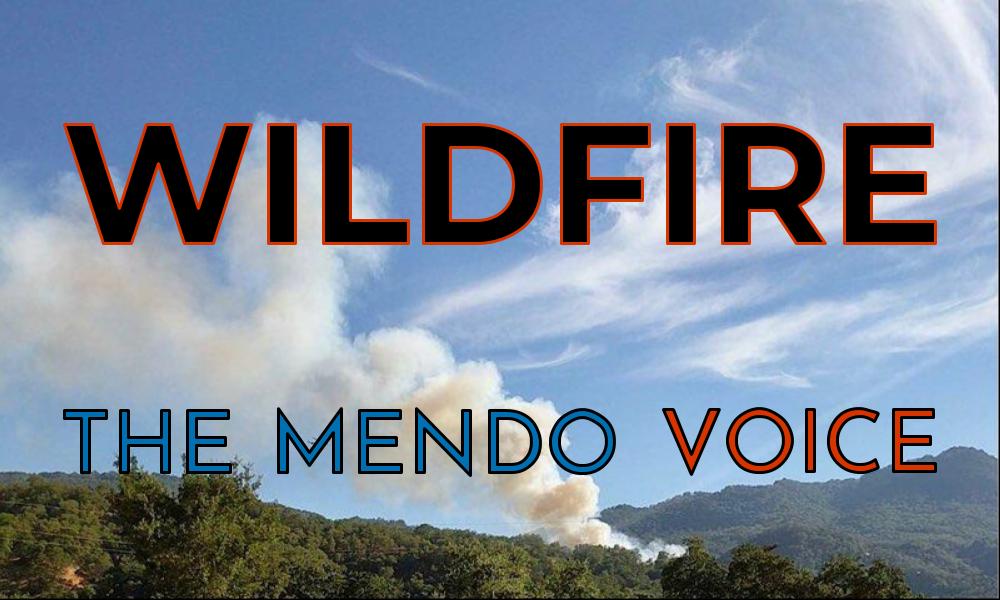MENDOCINO Co, CA, 12/20/22 — The results are in for a Wildfire Recovery and Resiliency Survey in Mendocino County, which helped identify unmet needs in the community following five large wildfires in the past five years. Travis Killmer, the disaster recovery field operations coordinator since summer of 2021, spearheaded the survey.
“I’m glad that people were willing to share with us,” he reflected in a phone conversation with The Mendocino Voice last week. “Even if they had critical feedback, that’s the only way we’re going to be able to make any changes here and improve the process.”
The very existence of the survey is a testament to the county’s progress in responding to disasters. For example, debris removal was not an outstanding problem for most impacted by more recent fires; but around 20.8% of 125 who had unmet needs from the Redwood Complex Fire, and 20% of 35 responders from the Mendocino Complex Fire, said debris removal was still an issue on their properties
“That’s one of the few things that normally, when we get assistance from the state or the federal government, we can take care of,” Killmer said. But he added, “Before the Redwood Complex fires, there was no ‘disaster recovery’ as a permanent unit in the county. So when things would happen, they pulled people from whatever departments they could — Planning and Building or Environmental Health — whoever they can get to try and get out there.”
Killmer and his colleagues in the division of Prevention, Recovery, Resiliency, & Mitigation (PRRM) will use the survey responses to inform grant applications, inter-departmental collaborations, and areas where the county should invest future time and funds. Some 288 people responded, a number Killmer had hoped would be higher, but that fellow county employees have told him represents a fairly high response rate for a county survey. Not all were impacted directly by fire, but the survey offered opportunities to reflect on impact in your town or city and voice concerns with county processes.
In that community-oriented category, 41.87% of 203 respondents hoped for hazardous fuels reduction in public right-of-ways; 62.31% of 199 respondents wanted safe alternative emergency routes; and 64.95% of 194 respondents wanted an increased supply of affordable housing. Other high priority wildfire and economic resiliency needs included improved emergency communications, hazardous tree removal, reforestation, enhanced employment opportunities, and increased high-speed internet access.
Many of the most specific concerns came in “Other” responses, in which participants could expand on their answers. Unfortunately, The Voice was not able to review these qualitative responses. The files were so large that Killmer was unable to export them; he plans to sort through people’s experiences to find unifying threads.
“There were some things that multiple people mentioned, but a lot of times it was just kind of all over the place: Why doesn’t the county do this? Or, you guys should have been doing X already,” he said. “I still need more time to wrap my head around that.”
Across each of the disasters — 2017’s Redwood Complex Fire, 2018’s Mendocino Complex Fire, 2020’s August Complex Fire and Oak Fire, and 2021’s Hopkins Fire — at least 18.5% of respondents in the unmet needs section identified “emotional support” as an area they considered lacking. For the Hopkins Fire, the number of respondents needing emotional support climbed up to 33.33%.
“It’s something that we’re already talking internally about, ways that we could help to address that or work with Behavioral Health,” Killmer said. “It’s not something that Disaster Recovery can really directly do anything about at the moment … it would really have to be led by Behavioral Health. At least that’s how I feel — we’re not qualified to provide those support services with Disaster Recovery. But that was very surprising to me, that it was that high across the fires. That was really the big one.”
Hazardous tree removal was another big issue across all five fires. Killmer expected this — responding crews only remove hazardous trees in public right-of-ways, and hazardous trees that would prevent them from doing rebuilding, debris clearing, or other work on private property. Otherwise, dead or dying trees impacted by wildfires remain standing on private land — though he’s hopeful that Supervisor John Haschak’s new tree mortality task force could help homeowners get those trees removed.
“The standing dead trees, no matter how [they] died, it’s not something you really want to have out there, because it just becomes a breeding ground for more insects, and it’s just sort of a snowballing effect,” he explained. He added, “It’s fairly expensive to take down a hazard tree if you’re paying someone who’s licensed and you’re doing it the right way. So even a million dollars doesn’t stretch that far, when you’ve got the number of hazard trees that we have around this county.”
The survey also offered an interesting look at how those impacted feel their recovery has progressed. The below graphs give a glance at this landscape for each of the five fires.
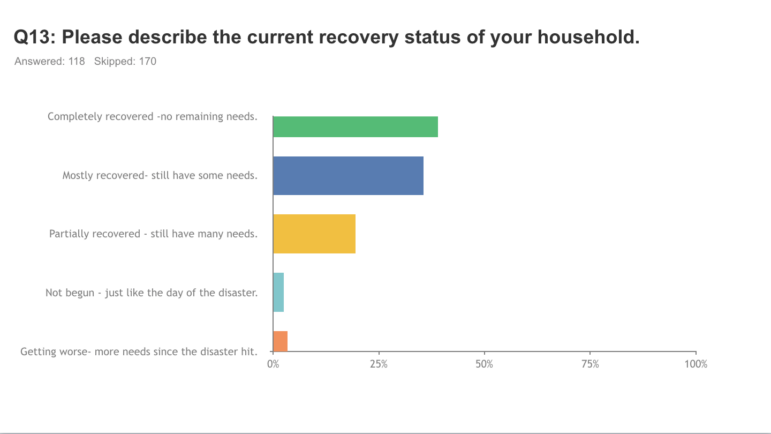
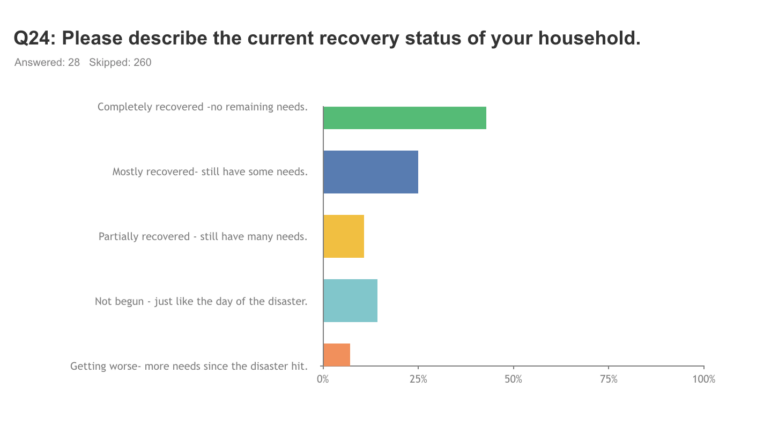
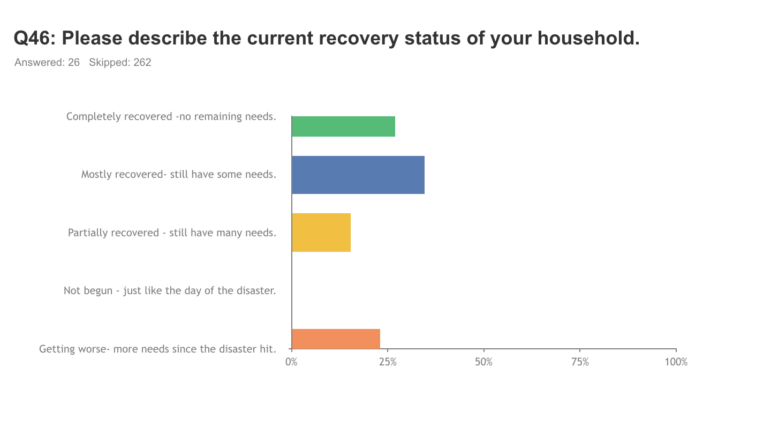
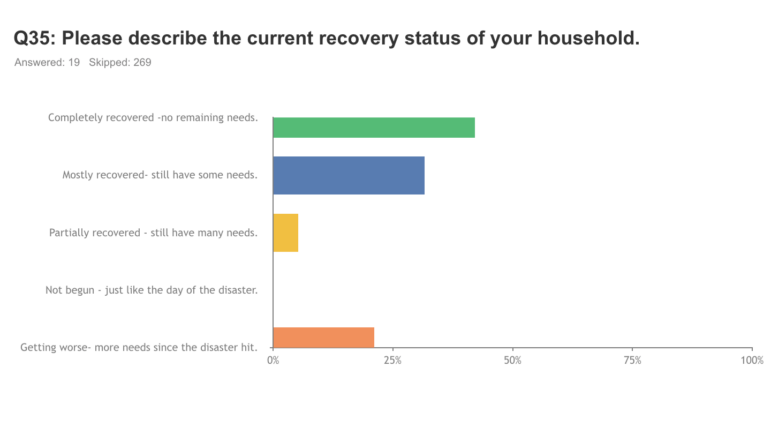
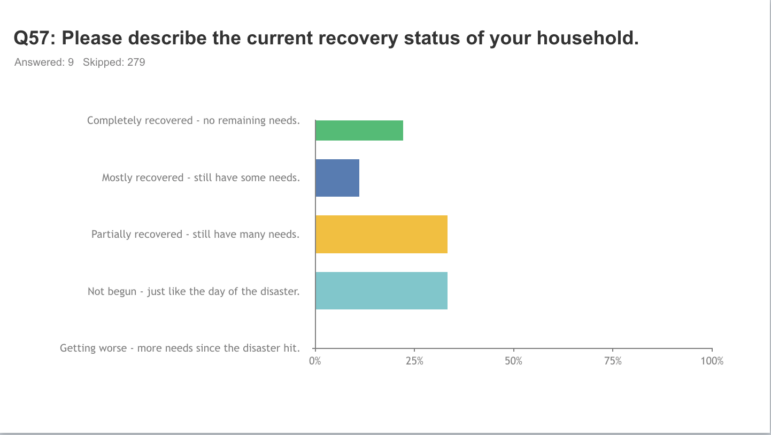
Killmer also hopes to have better case management capacities in the future, for PRRM to follow up with those impacted by disaster and not lose touch in the years following a given wildfire. He said some surveys sent to survivors of less recent fires were returned to sender, though he was able to contact survivors of the Hopkins Fire directly to offer a heads-up about the survey.
“That wasn’t something I could really do for the older fires, because I just didn’t have the contact information,” he explained. “And it would have been very time-consuming for me to do by myself. …It’s something that I would personally like to see the county invest a little more in.”
Though not everyone surveyed was impacted directly by wildfires in terms of a home lost, impacted business, or suffering agricultural loss, the demographics of respondents did give a valuable indication of how wildfire impact is spread across Mendocino County. The majority of respondents — around 45.25% — had income between $25,000 and $99,000, with 16.29% in the lower range of $25,000 to $49,000. Some 46.61% of respondents were older than 65.
Around 97.67% of respondents said English is their primary or preferred language, which was not a surprising response as the survey was only offered in English.
Killmer found it hard to get the survey translated into Spanish. “If I were to do it again, I would want [a translation],” he said. “It would have just taken a lot more time, and I don’t speak Spanish, so I would have had to get someone else to do the translation for me. But I wasn’t super comfortable not having one knowing that, I think, we would have gotten a more robust response.”
Killmer plans to have Spanish-speaking county staff on hand at a series of in-person community engagement meetings Mendocino County will conduct this spring. He expects to have the meetings scheduled by the end of January in locations around the county during March and April. He wants as many county staff from different departments available as possible, hopes to avoid potentially hazardous weather, and wants to make sure the meetings are held ahead of critical fire season.
“It all comes down to funding, and that’s always the problem,” he said. “But my hope is that [the survey and meetings] will at least help us in looking for the right kinds of grants out there. If we know there’s a problem that we haven’t been aware of before, at least now it’s on our radar, and we can start trying to find some funding to match up to those projects or problems.”
Note: Kate Fishman covers the environment & natural resources for The Mendocino Voice in partnership with a Report For America. Her position is funded by the Community Foundation of Mendocino, Report for America, & our readers. You can support Fishman’s work with a tax-deductible donation here or by emailing [email protected]. Contact her at KFishman@mendovoice.com or at (707) 234-7735. The Voice maintains editorial control and independence.


